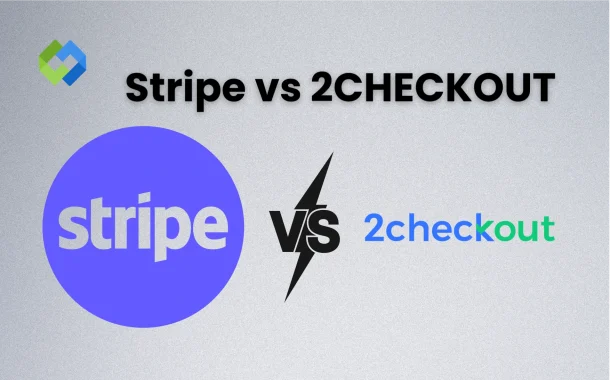If you choose the wrong one, you might face high fees, delays, or limited payment options. This can hurt your sales and customer experience. The right processor should match your business size, location, and type of product.
Table of Contents
Table of Contents
Core Features
Stripe’s Core Features
Stripe is designed for modern online businesses.
- It supports credit and debit cards, Apple Pay, Google Pay, ACH bank transfers, and buy now, pay later services like Klarna and Afterpay.
- Stripe offers powerful tools for subscriptions, invoices, and recurring billing.
- The dashboard is clean and allows full control over transactions and customer management.
- Developers prefer Stripe for its flexible API, which allows full customization and automation.
2Checkout’s Key Capabilities
2Checkout (now Verifone) is made for selling products and services worldwide.
- It supports global cards, PayPal, and localized payment options like iDEAL, Boleto, and SEPA.
- Businesses can use 2Checkout without registering local legal entities in different countries.
- It handles taxes, compliance, and localization automatically.
- Its built-in tools are great for digital goods, subscriptions, and physical product sales.
Ease of Use and Integration Options
Stripe’s Ease of Use
Stripe has a clean and modern look. But it’s mainly built for developers. The dashboard is simple, but setting it up fully often needs some coding. Stripe provides guides and help docs, but many advanced features are technical. It’s best for businesses that have a tech team or want to build a custom system.
2Checkout’s Ease of Use
2Checkout is much easier for beginners. It has a smooth setup and doesn’t require any coding. The platform gives you a step-by-step process to follow. Even if you don’t have technical skills, you can start quickly. It’s ideal for small businesses and solo sellers.
Stripe Integration Options
Stripe works well with many custom systems. It supports advanced API integration and connects with billing tools, apps, and CRMs. You can also use it with coding frameworks and mobile apps. Stripe gives full control, but setup takes time.
2Checkout Integration Options
2Checkout is more plug-and-play. It supports quick integration with Shopify, WooCommerce, and other platforms. You don’t need to write code. Hosted checkout pages are also available. It’s perfect if you want a faster and simpler solution.
Pricing and Transaction Fees
Stripe’s Pricing Model
Stripe follows a clear pricing structure. For most card payments, it charges 2.9 percent plus 30 cents per successful transaction. The exact rate may change depending on the country or card type. Stripe may also charge extra for services like international payments, currency conversion, or advanced fraud protection. There are no setup fees or monthly charges. This makes Stripe a flexible option for startups and growing online businesses.
2Checkout’s Pricing Structure
2Checkout uses a tier-based pricing plan. The basic plan, called 2Sell, starts at 3.5 percent plus 35 cents per sale. Other plans, like 2Subscribe and 2Monetize, include more features for subscriptions, digital product sales, and global tax support. These plans come with higher fees. While 2Checkout’s pricing is slightly higher than Stripe’s, it includes more built-in tools. This can be useful for businesses selling in many countries.
Global Reach and Currency Support
Stripe’s Global Availability
Stripe is available in over 45 countries. It covers major markets like the United States, Canada, the United Kingdom, Australia, and much of Europe. It also supports some parts of Asia and Latin America. While Stripe continues to expand, it is not available in every country. Businesses in supported regions can use Stripe to accept payments from customers around the world.
Stripe’s Currency Support
Stripe supports more than 135 currencies. It lets customers pay in their local currency, which helps improve conversion rates. Stripe also handles automatic currency conversion. However, there may be extra fees when converting between currencies. This is helpful for businesses that sell internationally and want to offer local pricing.
2Checkout’s Global Reach
2Checkout has a wider global presence. It supports sellers in over 200 countries and allows payments from almost anywhere. Unlike Stripe, you don’t need to have a local business entity in every country you sell in. This makes it a strong choice for businesses with a global audience.
2Checkout’s Currency Handling
2Checkout supports transactions in multiple currencies. It allows customers to pay in their preferred currency, making the checkout experience easier. It also includes built-in currency conversion. This helps reduce friction during international sales and builds trust with buyers across different regions.
Security, Compliance, and Fraud Protection
Stripe’s Security Features
Stripe takes security seriously. It is fully PCI compliant, which means it follows strict rules for handling card data. Stripe never stores card details on your servers, keeping your customer data safe. It also uses encryption and tokenization to protect payment information during every transaction.
Stripe’s Fraud Protection Tools
Stripe offers a built-in fraud detection system called Radar. It uses machine learning to spot risky transactions. You can also set custom rules to block certain payments. Radar helps reduce chargebacks and alerts you when something seems unusual. For businesses with higher risk, there is an upgraded Radar plan for more protection.
2Checkout’s Compliance Standards
2Checkout is also PCI compliant and follows global data protection laws like GDPR. It handles all sensitive payment data on its own secure servers. This means you don’t need to worry about storing card info or meeting complex security requirements yourself.
2Checkout’s Fraud Management
2Checkout uses its own fraud prevention system. It checks each transaction in real time to block suspicious activity. It also includes tools to handle chargebacks and prevent losses. With its focus on global sales, 2Checkout adapts its fraud checks to different regions and payment methods. This makes it safer for sellers working in multiple markets.
Conclusion
Stripe and 2Checkout are both good payment platforms. Stripe is better for businesses that need control, custom features, and modern tools. It works well for developers and startups in supported countries. It offers strong APIs, fast payments, and flexible pricing.
2Checkout is great for global sellers. It supports more countries and payment options. It’s easier to set up and doesn’t need coding skills. If you want to reach international buyers quickly, 2Checkout is a smart choice. Pick the one that fits your business needs, size, and target market.














